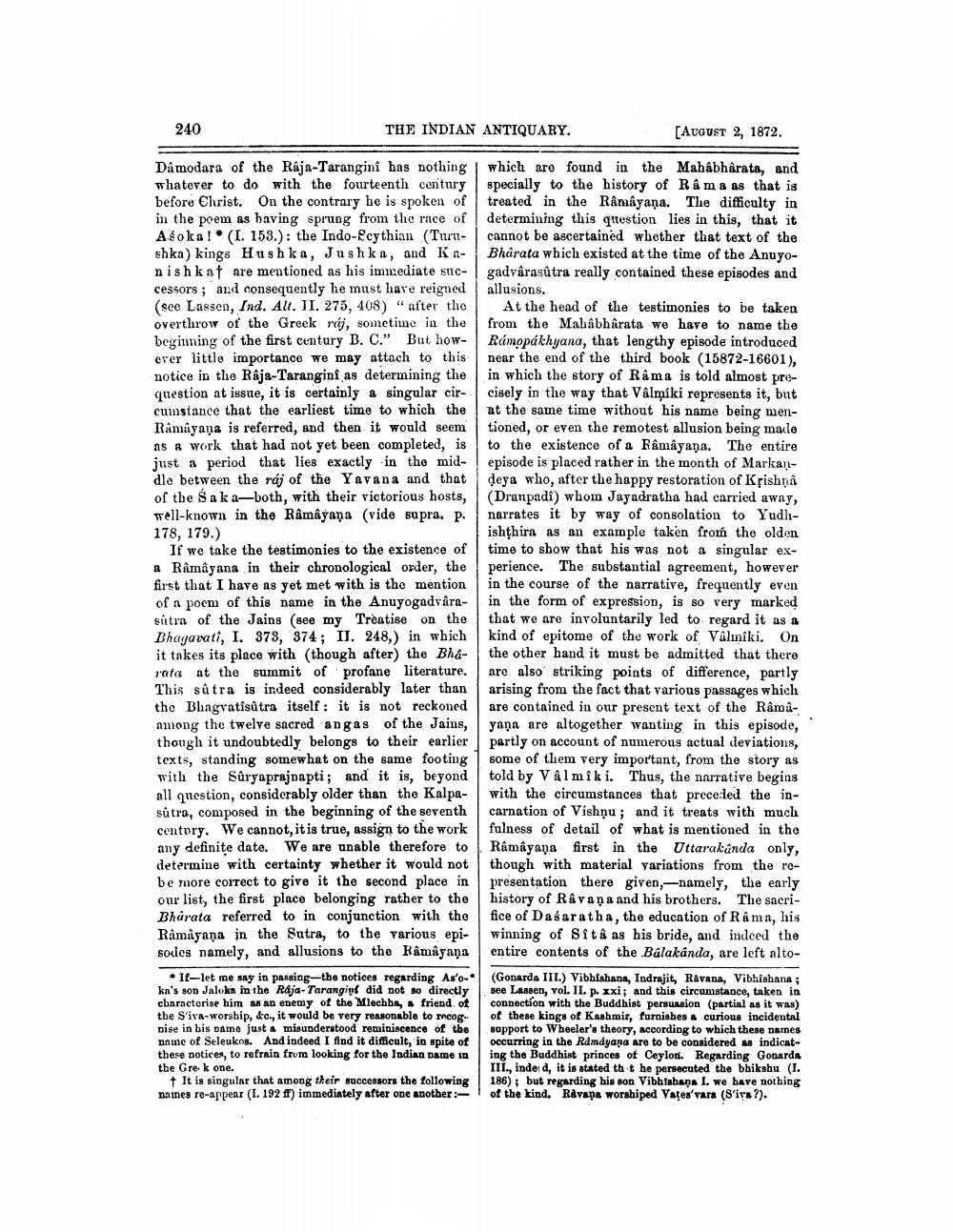________________
240
THE INDIAN ANTIQUARY.
[AUGUST 2, 1872.
Damodara of the Raja-Taranginî has nothing whatever to do with the fourteenth century before Christ. On the contrary he is spoken of in the poem as having sprung from the race of Aloka!. (I. 153.): the Indo-Ecythian (Turn shka) kings Hushka, Jushka, and KAnish kat are mentioned as his immediate successors; and consequently he must have reigned (see Lassen, Ind. AU. II. 275, 408) "after the overthrow of the Greek ráj, sometime in the beginning of the first century B. C." But howerer little importance we may attach to this notice in the Raja-Taranginf as determining the question at issue, it is certainly a singular circumstance that the earliest time to which the Ramayana is referred, and then it would seem as a work that had not yet been completed, is just a period that lies exactly in the middle between the ráj of the Yavana and that of the Saka—both, with their victorious hosts, well-known in the Ramayana (vide supra. P. 178, 179.)
If we take the testimonies to the existence of a Ramayana in their chronological order, the first that I have as yet met with is tho mention of a poem of this name in the Anuyogadvarasútra of the Jains (see my Treatise on the Bhagavati, I. 373, 374; II. 248,) in which it takes its place with though after) the Bharata at the summit of profane literature. This sůtra is indeed considerably later than the Bhagvatisútra itself: it is not reckoned among the twelve sacred angas of the Jains, though it undoubtedly belongs to their earlier texts, standing somewhat on the same footing with the Sûryaprajnapti; and it is, beyond all question, considerably older than the Kalpasůtro, composed in the beginning of the seventh century. We cannot, it is true, assign to the work any definite date. We are unable therefore to determine with certainty whether it would not be more correct to give it the second place in our list, the first place belonging rather to the Bharata referred to in conjunction with the Ramayana in the Sutra, to the various episodes namely, and allusions to the Ramayana
which are found in the Mahabharata, and specially to the history of Rama as that is treated in the Ramayana. The difficulty in determining this question lies in this, that it cannot be ascertained whether that text of the Bharata which existed at the time of the Anuyogadvarasútra really contained these episodes and allusions.
At the head of the testimonies to be taken from the Mahabharata we have to name the Rámopakhyana, that lengthy episode introduced near the end of the third book (15872-16601), in which the story of Rama is told almost precisely in the way that Valmiki represents it, but at the same time without his name being mentioned, or even the remotest allusion being male to the existence of a Râmâyana. The entire episode is placed rather in the month of Markandeya who, after the happy restoration of Kțishna (Dranpadi) whom Jayadratha had carried away, narrates it by way of consolation to Yudhishthira as an example taken from the olden time to show that his was not a singular experience. The substantial agreement, however in the course of the narrative, frequently even in the form of expression, is so very marked that we are involuntarily led to regard it as a kind of epitome of the work of Vâlniki. On the other hand it must be admitted that there are also striking points of difference, partly arising from the fact that various passages which are contained in our present text of the Râm lyaņa are altogether wanting in this episode, partly on account of numerous actual deviations, some of them very important, from the story as told by V Almiki. Thus, the narrative begins with the circumstances that prece:led the incarnation of Vishņu; and it treats with much fulness of detail of what is mentioned in the Ramayana first in the Uttarakanda only, though with material variations from the representation there given,-namely, the early history of Ravaņa and his brothers. The sacrifice of Dasaratha, the education of Rama, his winning of Sitâ as his bride, and indeed the entire contents of the Balakanda, are left alto(Gonarda III.) Vibhishana, Indrajit, Råvada, Vibhishana ; see Lassen, vol. II. p. xxi; and this circumstance, taken in connection with the Buddhist persuasion (partial as it was) of these kings of Kashmir, furnishes & curious incidental support to Wheeler's theory, according to which these names occurring in the Ramdyana are to be considered as indicating the Buddhist princes of Ceylon. Regarding Gonarda III., inded, it is stated th the persecuted the bhikshu (I. 186); but regarding his son Vibhishana I. we have nothing of the kind. Råvand worshiped Yates'vara (S'ira ?).
* If-let me say in passing-the notices regarding As'o. ka's son Jaloka in the Rája-Tarangint did not so directly characterise him as an enemy of the Mlechba, a friend of tbe S'ira-worship, &c., it would be very reasonable to recognise in bis dame just a misunderstood reminiscence of the name of Seleukos. And indeed I find it difficult, in spite of these notices, to refrain from looking for the Indian name in the Grek one.
It is singular that among their successors the following naines re-appear (1. 192 ff) immediately after one another :-




